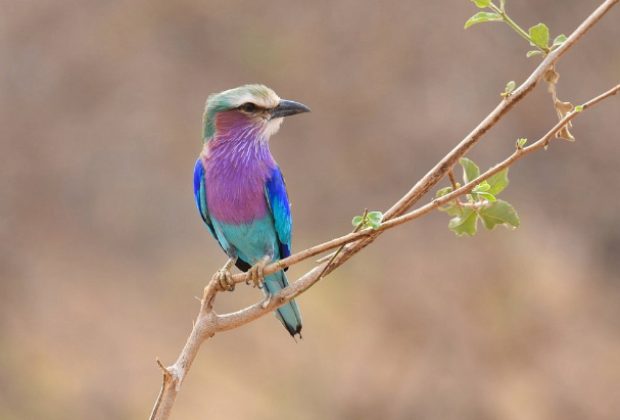Tanzania is one of the finest bird-watching destinations in Africa, with 1140 species including 200 migrants and 74 marine birds present. Tanzanian avian safaris are best in the rains for migrants and residents in breeding plumage. The preeminent birding locations include Arusha National Park, with 400 birds in a diversity of habitats contained in a small area. You may observe on a white-faced whistling duck, with its whistling three-note lament, or a dusky flycatcher.
Here’s everything you need to know about bird watching in Tanzania:
- Best Time to Go: The best time for bird watching in Tanzania is during the green season (November to April), when migratory birds are present and resident birds are breeding. However, birding can be done all year round, and each season offers its own unique birding experiences.
- Top Birding Destinations: Tanzania is home to several top birding destinations, including the Serengeti, Lake Victoria, Saadani National Park, Usambara Mountains, Udzungwa Mountains and Nyerere National Park. Each of these parks offers a different set of bird species, habitats, and experiences.
- Bird Species to Look Out For: Tanzania is home to many endemic and sought-after bird species, including the Shoebill, African Grey Parrot, Yellow-throated Sandgrouse, and Fischer’s Lovebird. Other bird species to look out for include the African Fish Eagle, Secretary Bird, and Lilac-breasted Roller.
- Birding Guides: Our professional birding guides will help you identify bird species, find specific species, and provide valuable insight into the local birdlife and habitat.
- Accommodation: All our lodges and tented camps in Tanzania offer bird watching as an activity, and are located in prime birding areas.
- Birding Tours: Tent With a View offers specialized bird watching tours in Tanzania. These tours typically last for several days and include visits to multiple birding destinations within the country.
Highlights of birding safaris in Tanzania
What to expect on birding safaris in Tanzania
Tanzania is home to ~1300 bird species, making for excellent bird-spotting. However, what makes bird watching in Tanzania special are the relationships that exist between birds, wildlife, and humans. Whether that is the oxpecker, the tick-remover of the savannahs; or the greater honeyguide, that leads the Hadza tribe to bee nests – an ancient relationship that rewards this entrepreneurial bird with the remaining wax and honey. Our guides will seek-out and share incredible symbiotic relationships, behaviour and even myths of the Tanzania birdlife.
Which birds can you see in Tanzania?
Tanzania with its vast differences in regions, climates and seasons is a bird watching paradise.
On top of every African bird-spotting-list should be the king of all African birds. No, not the Kingfisher, the black-and-white Sacred Ibis, or the regal looking and endangered Grey Crowned Crane, but the Hamerkop – a species of bird that falls between the herons and the stalks.
The legend of the Hamerkop
The Hamerkop, as African-legend goes is the king of all African birds with the ability to control the rains and the flooding of the rivers.
Apart from a distinct hammer-shaped-head, they are not very spectacular. Nor is their false-mounting display regal. They were crowned king, partly because every other species of bird brings a contribution to help to construct their extraordinarily large nests, which can take three-months to build.
Silver birds, Grey Kestrel, and Egyptian Geese visit the nest and appear, to a passerby, to help build it. Watch them for longer and you will discover that these birds use Hamerkop nests as a building supplier and take material for their own needs.
The Hamerkops legendary status is reinforced by their unique post-mating behaviour of never stopping adding to the roof of their nest and fascinatingly, they decorate their royal palace with warthog tusk, porcupine quills, snake skins and even wildebeest-tails.
The legend as the king has been cemented in time thanks to Africa’s largest owl, the Verreaux’s Eagle-Owl, who nests in the top of abandoned Hamerkop nests. Believed to have super natural powers, these huge and beautiful birds seemingly guard the palace of the king.
Other birds in Tanzania
Whilst not as beautiful as the Common Ostrich, the Lilac-Breasted Roller or the Livingston’s Turacos; or as powerful as the Bateleur Eagle or the Fish Eagle; or as intriguing as the display of the Long-tailed Widowbird and the nesting behaviour of the African Grey Hornbill (females cement themselves into a tree-hollow for five weeks to incubate their eggs); or not as crucial to the savannahs as the many carrion birds, such as the White-backed Vulture (whose numbers have halved in the last 50 years), the Hamerkop with their large decorated nest will always be known as the king of African birds who has control of the rain.
Not only that, but their annual abandonment of the nest creates homes for a vast number of birds, reptiles and small mammals.
Join one of unique bird watching tours to Tanzania to discover, learn and be amazed by the prolific birdlife found here.
What to bring on your birding safari to Tanzania?
Apart from the normal packing list to Tanzania, here are some suggestions of what to bring on your bird watching safari:
- A pair of binoculars
- A good hat
- A pair of sunglasses with polarized lenses to reduce glare, protect your eyes and provide additional clarity.
- A pocket notebook for any field notes.
- And most importantly, a good guidebook for identifying East African birds. We recommend the following two books:
- The Birds of East Africa by Terry Stevenson and John Fanshawe. With this book you can identify birds found in Tanzania, Kenya, Uganda, Rwanda and Burundi.
- Birds of Kenya and Northern Tanzania by Dale A. Zimmerman, David J. Pearson, Donald A. Turner. A wonderfully illustrated book.
What to else can you see on birding safaris in Tanzania?
Whilst bird watching is the main-act on a bird watching safari to Tanzania, you will see a vast array of wildlife during your trip. You may be experiencing the ballooning-throated-call from a pair of Ground Hornbill, whilst in the background a pride of lions could be lying in the shade. Or swirling vultures, a bird watchers delight, indicate where a kill has just taken place and you are likely to see a predator such as cheetah, hyena, and jackals. Or watching Weaver Birds building their nest over a river could enable you to see a herd of wading elephant or Nile crocodiles patrolling the river. The possibilities are endless.
Our guides are experts in both East-African birds and wildlife. To find out more you can contact one of our country experts.
Tanzania Top Birding destinations
- Serengeti National Park
- Ngoronogoro Crater
- Arusha National Park
- Ruaha National Park
- Rubondo Island National Park
- Lake Victoria
- Lake Natron
- Lake Eyasi
- Lake Manyara
- Lake Tanganyika
- Usambara Mountains
- Mt. Kilimanjaro
Arusha National Park
The verdant grassy hills surround the tranquil beauty of the Momela Lakes, all shimmering in shades of green and blue. Their shallows sometimes host Pink Flamingos in their thousands. These lakes support a rich selection of resident and migrant waterfowl, and shaggy waterbucks line the watery fringes. Giraffes lope along the grassy hills between dazzling zebra herds, while pairs of wide-eyed Dik-Dik dart into scrubby bush like overgrown hares on spindly legs.
Lake Victoria
This Lake is home to over 400 species of birds, which makes it easy to view them in a few days. White and Pink-backed Pelican, Cormorant and Long-tailed Cormorant, Little Bittern, Goliath, Purple and Squacco Heron, Little, Yellow-billed and Great-white Egrets, Hammerkop, Yellow-billed Stork, Sacred Ibis, African Spoonbill, Fish Eagle, Black Crake, Allen’s and Purple Gallinules, Jacana, and Pied and Malachite Kingfishers are all residents. With a surface area of just under 70 000 km², Lake Victoria is the second-largest freshwater lake in the world. But despite its size, it is fairly shallow, only reaching 75m at its deepest.
Mount Kilimanjaro
This is the world’s tallest freestanding mountain, the summit of which is 5,895 meters (19,341 feet) above sea level. Highland species here include several extremely uncommon birds such as Green Ibis, Rufous Sparrowhawk, Mountain Buzzard, Crowned Eagle, Jackson’s Francolin, Bronze-naped Pigeon, Red-fronted Parrot, Hartlaub’s Turaco, Scarce Swift, Silvery-cheeked Hornbill, Moustached Green Tinkerbird, Montane Oriole, Alpine Chat, Abyssinian Ground Thrush, Sharpe’s Longclaw, Slender-billed Chestnut-winged Starling, and 13 species of sunbirds including the Northern Double-collared, Golden-winged, Tacazze, Green-headed and Scarlet-tufted Malachite.
Serengeti National Park
Serengeti National Park, the Ngorongoro Conservation Area, and the Maasai Mara Game Reserve across the border in Kenya, protect the largest and most diverse collection of terrestrial wildlife on Earth, and remains one of the last great migratory systems still intact. The Serengeti is the jewel in the crown of Tanzania’s protected areas, which calculated together, make up some 14% of the country’s land area. This is a conservation record that few countries come close to.
Usambara Mountains
These mountains and tropical forests are considered incredibly significant ecologically and as a Biodiversity hotspot. There are protected zones throughout the range which are still being expanded and contributed to by the Tanzanian government, associated NGO’s and research teams, and donor countries. The Usambara Mountains are fairly unique in East Africa with their natural areas still being cloaked in tropical forests, which are otherwise seen primarily in Western Africa.


